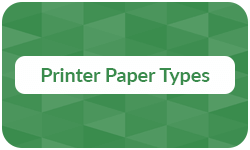
When it comes to printing, not all paper is created equal. Whether you’re printing simple documents, colorful presentations, or high-quality photos, the type of paper you use can make a difference in how your prints look and feel. In this article, we’ll walk you through common printer paper types, what makes them unique, and when to use them. By the end, you’ll know exactly which paper is right for your next print job.
Inhaltsverzeichnis
Overview of printer paper types
Printer paper comes in various types, each designed for specific printing needs and types of printers. From basic copy paper to glossy photo sheets, understanding the differences between them can help you achieve the best possible print quality. In this section, we’ll cover the most common printer paper types and what makes each one of them special.
| Paper | Uses | Features |
| Bond paper | Used for official documents, forms, and stationery. | Bond paper is durable and features a smooth finish, making it ideal for writing and printing high-quality documents. |
| Book paper | Suitable for printing books and publications in general. | Book paper is lightweight and opaque, optimized for readability, and perfect for printing books and other publications. |
| Bright white paper | Used for high-quality documents and image-intensive prints. | Bright white paper is ultra-bleached to provide exceptional brightness and contrast, ensuring crisp printouts and vivid images. |
| Environmentally focused printing and office use. | Carbon-neutral paper is produced with eco-friendly practices that offset carbon emissions, offering a sustainable option without sacrificing print quality. | |
| Coated paper | Used for high-quality prints, graphics, and photos. | Coated paper has a specially treated surface that improves ink holdout and produces sharper, more vibrant prints. |
| Copy paper | Commonly suitable for everyday printing and copying. | Copy paper is lightweight, affordable, and versatile, making it the go-to choice for daily printing and copying tasks. |
| Fine art paper | Art reproductions, professional portfolios, and gallery prints. | Fine art paper is made for premium color accuracy and longevity, with a textured surface that adds depth and artistic quality to fine art reproductions. |
| Glossy Paper | Used for photo prints, brochures, and flyers. | Glossy paper boasts a high shine that enhances color vibrancy, resulting in eye-catching photo prints, brochures, and flyers. |
| Heavyweight paper | Premium documents, brochures, and business cards. | Heavyweight paper is a premium paper that offers increased thickness for high-end print materials and professional documents. |
| Inkjet paper | Specially designed printer paper for inkjet printers. | Inkjet paper is made to absorb liquid ink efficiently, ensuring clear images without smudging. |
| Kraft paper | Suitable for everything related to packaging, arts, and crafts. | Kraft paper is paper produced from chemical pulp and offers a natural, brown, coarse texture and exceptional durability. |
| Laid paper | Often used for certificates and other formal documents. | It features a distinct pattern of parallel lines that adds a refined texture, perfect for certificates and other formal documents. |
| Linen paper | Invitations, letterheads, and professional documents. | Linen paper is best for invitations, letterheads, and professional documents. |
| Matte paper | Used for professional documents and presentations. | Matte paper has a non-reflective, soft surface that minimizes glare and is excellent for reading. |
| Metallic paper | Suitable for decorative projects and invitation cards. | Metallic paper is characterized by a reflective finish with a metallic luster that adds a decorative touch to projects and invitations. |
| Mirror paper | Perfect for special effect printing and craft projects. | Mirror paper features an ultra-reflective, glossy surface on one side, creating a striking visual effect for special projects and creative designs. |
| Newsprint paper | Most suitable for newspapers and draft prints. | Newsprint paper is thin and inexpensive, with a slightly rough texture that works well for newspapers and draft prints. |
| Perforated paper | Tear-off forms, coupons, and anything requiring easy separation. | Perforated paper is designed with pre-cut perforations that allow for clean, easy tearing along a defined line, making it ideal for forms and tear-off pages. |
| Photo paper | Used for printing photographs and detailed images. | Photo paper is designed with a high-brightness coating that produces vivid colors and detailed images, making it ideal for photo printing. |
| Recycled paper | Perfect choice for eco-friendly everyday printing. | Recycled paper is made from environmentally friendly materials while maintaining performance comparable to standard paper for everyday printing. |
| Resume paper | Resumes, cover letters, and professional documents. | Resume paper is smooth and slightly heavier than standard copy paper, providing a professional texture and a refined aesthetic for important documents. |
| Satin paper | Mostly used for brochures, flyers, and photos. | Satin paper features a smooth surface with a subtle sheen that balances vibrancy with readability, making it suitable for printing brochures, flyers, and photos. |
| Silk paper | Ideal choice for premium prints with a soft feel. | Silk paper has a luxurious, silky texture combined with a semi-gloss finish, offering premium quality for high-end print projects. |
| Thermal paper | Used for receipts, shipping labels, and tickets. | Thermal paper is heat-sensitive and features a special chemical coating that darkens when exposed to heat. Many thermal printers are compact, enabling fast and ink-free printing. |
| Tracing paper | Technical drawings and architectural plans. | Tracing paper is semi-transparent and exceptionally smooth, which is ideal for precise technical drawings and detailed architectural plans. |
| Uncoated paper | Used for text documents, books, and general use. | Uncoated paper retains its natural texture without any coating, which makes it easy to write on and very suitable for many everyday tasks. |
| Vellum paper | Suitable for architectural drawings and overlays. | Vellum paper is translucent and possesses a crisp surface, commonly used for overlays and detailed architectural drawings. |
| Waterproof paper | Suitable for outdoor use, documents requiring water resistance, and marine applications. | It is designed with a water-resistant coating that prevents moisture from damaging the print to ensure durability even in damp conditions. |
| Wove paper | Mainly used for books, envelopes, and stationery. | Wove paper is known for its smooth, uniform surface with no visible texture, making it a versatile choice for books, envelopes, and stationery. |
Copy and print from $0.10
- High-quality copies & prints for any project
- Vibrant color prints or sharp black & white prints
- Online copy and print services delivered straight to your door
Learn more!
Tips for buying printer paper
With so many paper options available, it can be tricky to know which one to pick. Your choice will depend on factors like the type of printer you’re using, what you’re printing, and the finish or weight you want. In this section, we’ll give you practical tips on how to select the right printer paper for any job.
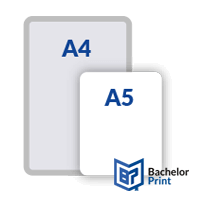
Size
Whether you need a standard A4, Letter, or another format, be sure the paper size matches your printer and the requirements of your project. Always check your printer’s specifications to make sure that it supports the paper size you plan to use. Using the correct size can also prevent paper jams and ensure that your document layout remains consistent.
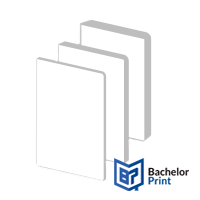
Weight
Paper weight is typically measured in gsm (grams per square meter) or lb. Heavier paper tends to have a more professional feel and is less prone to jamming, while lighter paper is more economical for everyday printing. The weight of your paper affects its durability and how it is processed in high-speed printers. For important documents or presentations, consider investing in a slightly heavier paper.
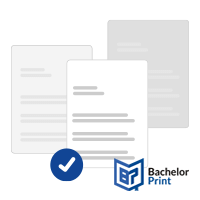
Brightness
Brightness affects how well your prints pop. High-brightness paper reflects more light, which results in crisper images and text. So, it can make colors appear more vivid on the page, which is especially important for marketing materials. When consistency is key, choosing printing paper with uniform brightness can make your documents look extra special.

Opacity
The opacity determines how much light passes through the paper. Buying paper with higher opacity prevents text or images from showing through on double-sided prints, which minimizes distractions and improves readability. High-opacity paper also helps in achieving sharper prints without bleed-through from the other side.
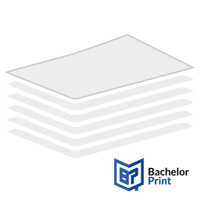
Ream
A ream is a bundle or standard package of paper, usually consisting of 500 sheets (also known as a long ream), although this can vary based on the printer paper type and manufacturer. When buying in bulk, consider the cost per ream to make sure that you’re getting a good deal without compromising quality.
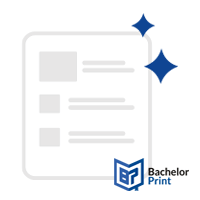
Material
The material used in the paper — either virgin or recycled — can impact both the print quality and the overall sustainability of your project. Virgin paper is made from new fibers, while recycled paper offers an eco-friendly option with a slightly different texture. Your choice of material may also affect the longevity of the print, particularly for archival purposes, e.g., for dissertation printing.
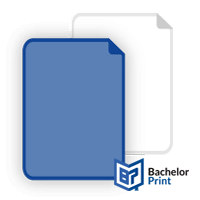
Coating
Coating or no coating, that is the question. Coated paper has a smooth finish that improves ink holdout and sharpness. Uncoated paper, on the other hand, offers a natural texture that works well for everyday use. The coating can also impact how your printer interacts with the paper, so choosing the right one can help reduce smudging.
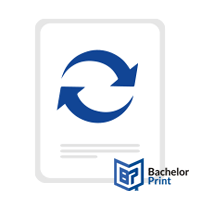
Eco-friendly
If sustainability is important to you, look for eco-friendly options like recycled paper or carbon-neutral paper (as seen in our online print shop). These products are designed to reduce environmental impact while still delivering quality prints. Eco-friendly paper often comes with certifications that verify its reduced environmental footprint. Also, it can appeal to clients and stakeholders who prioritize sustainability.
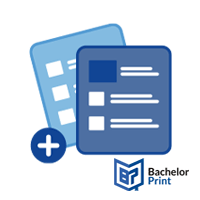
Color
The color of the paper affects the overall appearance of your printed documents. Bright white paper is commonly used for high-contrast prints. Alternatively, off-white or tinted options can be easier on the eyes during prolonged reading and give a more classic or sophisticated feel to your materials. Consider the purpose and audience of your document when selecting a paper color to match the desired tone and impact.
Affordable document printing from $0.10
- Crisp text, vibrant colors & multiple paper choices
- No need to visit a shop; simply order online anytime
- Print documents, copies & reports with professional quality
Learn more!
FAQs
Printer paper comes in many varieties, including:
- Copy paper: For everyday printing and copying.
- Inkjet paper: Specifically designed to absorb liquid printing ink without smudging.
- Laser paper: Engineered to withstand high heat from laser printers.
- Photo paper: Coated for high brightness and vibrant images.
The best paper depends on your printing needs. For everyday documents, standard copy paper (around 80 gsm) is ideal. For high-quality images or presentations, choose a paper type that matches your printer, like inkjet photo paper for vibrant images or premium paper for professional presentations.
The highest quality paper is typically found in the premium category. This includes heavyweight and fine art papers that offer superior brightness, smoothness, and texture. These papers are engineered to provide exceptional print clarity and longevity.
Yes, printer paper varies widely by factors such as weight, brightness, opacity, texture, and coating. These differences impact print quality, ink absorption, and overall appearance.
Not all papers are compatible with every printer. Each printer (inkjet, laser, or specialty) requires paper that is designed for its printing process. Using the wrong type of paper can lead to issues like poor print quality, smudging, or even damage to your printer. Always refer to your printer’s guidelines to ensure compatibility.